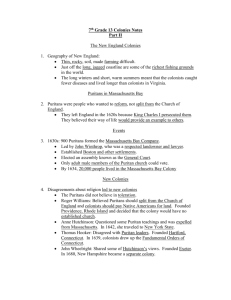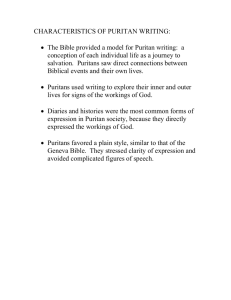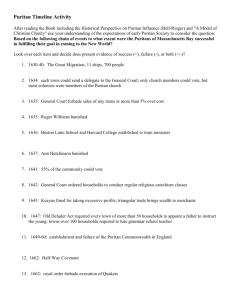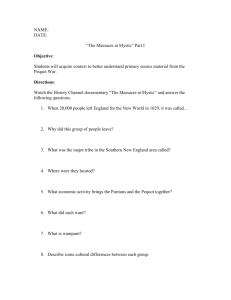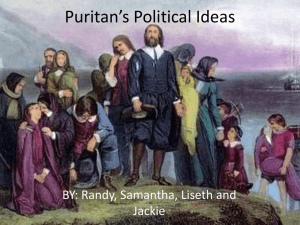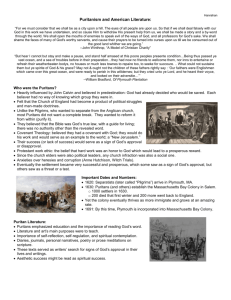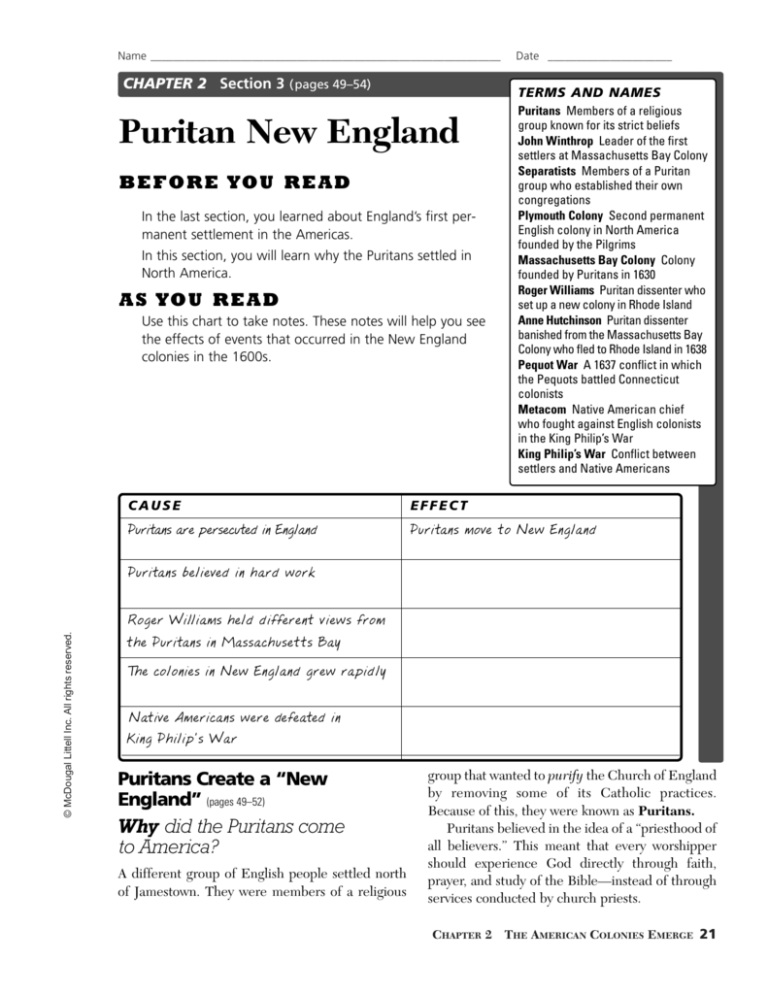
Name ______________________________________________________________
CHAPTER 2 Section 3 (pages 49–54)
Puritan New England
BEFORE YOU READ
In the last section, you learned about England’s first permanent settlement in the Americas.
In this section, you will learn why the Puritans settled in
North America.
AS YOU READ
Use this chart to take notes. These notes will help you see
the effects of events that occurred in the New England
colonies in the 1600s.
Date ______________________
TERMS AND NAMES
Puritans Members of a religious
group known for its strict beliefs
John Winthrop Leader of the first
settlers at Massachusetts Bay Colony
Separatists Members of a Puritan
group who established their own
congregations
Plymouth Colony Second permanent
English colony in North America
founded by the Pilgrims
Massachusetts Bay Colony Colony
founded by Puritans in 1630
Roger Williams Puritan dissenter who
set up a new colony in Rhode Island
Anne Hutchinson Puritan dissenter
banished from the Massachusetts Bay
Colony who fled to Rhode Island in 1638
Pequot War A 1637 conflict in which
the Pequots battled Connecticut
colonists
Metacom Native American chief
who fought against English colonists
in the King Philip’s War
King Philip’s War Conflict between
settlers and Native Americans
CAUSE
EFFECT
Puritans are persecuted in England
Puritans move to New England
Puritans believed in hard work
© McDougal Littell Inc. All rights reserved.
Roger Williams held different views from
the Puritans in Massachusetts Bay
The colonies in New England grew rapidly
Native Americans were defeated in
King Philip’s War
Puritans Create a “New
England” (pages 49–52)
Why did the Puritans come
to America?
A different group of English people settled north
of Jamestown. They were members of a religious
group that wanted to purify the Church of England
by removing some of its Catholic practices.
Because of this, they were known as Puritans.
Puritans believed in the idea of a “priesthood of
all believers.” This meant that every worshipper
should experience God directly through faith,
prayer, and study of the Bible—instead of through
services conducted by church priests.
CHAPTER 2 THE AMERICAN COLONIES EMERGE 21
1. Why did the colonists at Massachusetts Bay
fare better at the beginning than the colonists
in Virginia?
Dissent in the Puritan
Community (page 52)
Why did some Puritans leave the
Massachusetts Bay Colony?
The Puritans came to America to practice their
religion in freedom. However, they did not like dissent, or the expression of other points of view.
22 CHAPTER 2 SECTION 3
A minister named Roger Williams preached
that the settlers should buy—not take—land from
Native Americans. He also said that government
officials should not punish those with different religious views. Williams’s views angered Puritan leaders. They soon ordered his arrest. In 1636, Williams
fled Massachusetts Bay. He settled a new colony in
what is now Rhode Island.
Anne Hutchinson also angered Church leaders with her beliefs. She argued that worshipers
should interpret the Bible on their own—without
the help of the church or its ministers. Puritan leaders banished Hutchinson from the colony in 1638.
She and her family went to Rhode Island.
2. Why did Puritan leaders force Roger Williams and
Anne Hutchinson to leave the colony?
Native Americans Resist
Colonial Expansion (pages 53–54)
How did Puritans treat Native
Americans?
At first, Puritans and the local Native Americans
helped each other. As New England grew, however,
settlers began to seize Native American lands. In
addition, the settlers tried to force the Native
Americans to accept Puritan laws and religion.
Many Native Americans saw the Puritans as a
threat to their way of life. The tense relationship
between the two groups soon led to war. In 1637,
the Pequot tribe, who lived in what is now
Connecticut, went to war with the colonists. The
Pequot War ended in total defeat for the Native
Americans. Most of the Pequot civilization was
wiped out.
War between Native Americans and colonists
broke out again in 1675. Chief Metacom, whom
the English called King Philip, led an alliance of
Native Americans against the settlers. King
Philip’s War lasted over a year. In the end, the
English won.
3. Why did Native Americans fight the Puritans?
© McDougal Littell Inc. All rights reserved.
Some Puritans believed in trying to change the
Church of England. Other Puritans chose to leave
the church and form their own congregations. They
were known as Separatists.
The English king punished anyone who broke
away from the Church of England. One Separatist
group, known today as Pilgrims, decided to leave
England. In 1620, they arrived in North America
and founded Plymouth Colony.
In 1630, another group of Puritans sailed to
North America. Like the Pilgrims, they came to
practice their religion without fear of punishment.
They started a settlement called the Massachusetts
Bay Colony. By 1640, more than 20,000 English
settlers lived there. The region would become
known as New England.
Unlike the settlers in Jamestown, the Puritans
were well prepared to live in this new land. They
were organized and had many supplies. John
Winthrop was the settlement’s first governor.
The Puritans wanted to create a society that all
people would look up to. All adult male members of
the Puritan Church could vote. The Puritans also
placed great importance on families and church
authority.
They also stressed hard work. No matter what
one’s duties were, Puritans believed that God
required men and women to work long and hard at
them. This “Puritan work ethic” helped lead to the
rapid growth and success of the New England
colonies.

